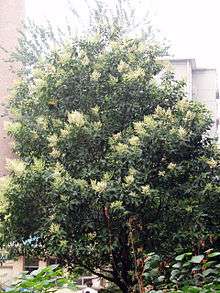Ligustrum lucidum
Ligustrum lucidum (broad-leaf privet,[1] Chinese privet[2] glossy privet,[3] tree privet[4] or wax-leaf privet) is a species of privet (genus Ligustrum), a flowering plant in the olive family, Oleaceae, native to the southern half of China and naturalized in many places: Spain, Italy, Algeria, Canary Islands, New Zealand, Lesotho, South Africa, Japan, Korea, Australia, Norfolk Island, Chiapas, Central America, Argentina, and the southern United States (California, Arizona, Maryland, and the southeast from Texas to North Carolina).[5][6][7] The name "Chinese privet" is also used for Ligustrum sinense.
| Ligustrum lucidum | |
|---|---|
 | |
| Scientific classification | |
| Kingdom: | Plantae |
| Clade: | Tracheophytes |
| Clade: | Angiosperms |
| Clade: | Eudicots |
| Clade: | Asterids |
| Order: | Lamiales |
| Family: | Oleaceae |
| Genus: | Ligustrum |
| Species: | L. lucidum |
| Binomial name | |
| Ligustrum lucidum | |
The Latin specific epithet lucidum means "bright" or "shiny", referring to the leaves.[8]
Description
Ligustrum lucidum is an evergreen tree growing to 10 m (33 ft) tall and broad. The leaves are opposite, glossy dark green, 6–17 centimetres (2.4–6.7 in) long and 3–8 centimetres (1.2–3.1 in) broad. The flowers are similar to other privets, white or near white, borne in panicles, and unpleasantly pungent.[9]
Ligustrum lucidum[2] and the variegated cultivar 'Excelsum Superbum'[10] have gained the Royal Horticultural Society's Award of Garden Merit.[11]
Uses
Ligustrum lucidum is often used as an ornamental tree, sometimes in variegated forms. It is also one of several species of privet used as dense, evergreen hedges, which can be trained to a specific size and shape by regular pruning.[9]
It has become an invasive species in some areas where it has been introduced, such as urban areas in the southeastern United States. It is classed as a noxious weed in New South Wales, Australia,[1] and is similarly listed in New Zealand's National Pest Plant Accord.
Ethnomedical uses
The seeds are known as nu zhen zi (female chastity seed/berry) in traditional Chinese medicine and are believed to nourish liver and kidney yin and jing in the treatment of tinnitus (ringing in the ears), vertigo (dizziness), premature graying of the hair, and soreness/weakness of the lower back and knees.[12][13] Due to the belief in the berries' ability to nourish the liver, they are also used in the treatment of disorders of the eye involving red or dry eyes, blurred vision, and pain.[14]
Etymology
Ligustrum means "binder".[15]
Gallery
 Ligustrum lucidum flowers
Ligustrum lucidum flowers Ligustrum lucidum berries
Ligustrum lucidum berries Ligustrum lucidum killed as weeds in an Australian rainforest
Ligustrum lucidum killed as weeds in an Australian rainforest
See also
References
| Wikispecies has information related to Ligustrum lucidum |
| Wikimedia Commons has media related to Ligustrum lucidum. |
- Weed profile: Privet, New South Wales Department of Primary Industries
- "RHS Plant Selector - Ligustrum lucidum". Retrieved 21 May 2013.
- "Ligustrum lucidum". Natural Resources Conservation Service PLANTS Database. USDA. Retrieved 24 January 2016.
- "BSBI List 2007". Botanical Society of Britain and Ireland. Archived from the original (xls) on 2015-01-25. Retrieved 2014-10-17.
- Kew World Checklist of Selected Plant Families, Ligustrum lucidum
- Biota of North America Program, Ligustrum lucidum
- Gavier-Pizarro, Gregorio I.; Kuemmerle, Tobias; Hoyos, Laura E.; Stewart, Susan I.; Huebner, Cynthia D.; Keuler, Nicholas S.; Radeloff, Volker C. 2012. "Monitoring the invasion of an exotic tree (Ligustrum lucidum) from 1983 to 2006 with Landsat TM/ETM+ satellite data and support vector machines in Cordoba, Argentina". Remote Sensing of Environment. 122: 134-145.
- Harrison, Lorraine (2012). RHS Latin for Gardeners. United Kingdom: Mitchell Beazley. ISBN 184533731X.
- RHS A-Z encyclopedia of garden plants. United Kingdom: Dorling Kindersley. 2008. p. 1136. ISBN 1405332964.
- "RHS Plant Selector - Ligustrum lucidum 'Excelsum Superbum'". Retrieved 21 May 2013.
- "AGM Plants - Ornamental" (PDF). Royal Horticultural Society. July 2017. p. 60. Retrieved 22 March 2018.
- "Chinese Privet (Ligustrum Lucidum, Nu Zhen Zi) | Chinese Herbs Healing". Retrieved 2019-05-18.
- Hu, Bing; Du, Qin; Deng, Shan; An, Hong-Mei; Pan, Chuan-Fang; Shen, Ke-Ping; Xu, Ling; Wei, Meng-Meng; Wang, Shuang-Shuang (September 2014). "Ligustrum lucidum Ait. fruit extract induces apoptosis and cell senescence in human hepatocellular carcinoma cells through upregulation of p21". Oncology Reports. 32 (3): 1037–1042. doi:10.3892/or.2014.3312. ISSN 1021-335X.
- "Fructus Ligustri Lucidi". shen-nong.com. Retrieved 2019-05-18.
- Gledhill, David (2008). "The Names of Plants". Cambridge University Press. ISBN 9780521866453 (hardback), ISBN 9780521685535 (paperback). p 237